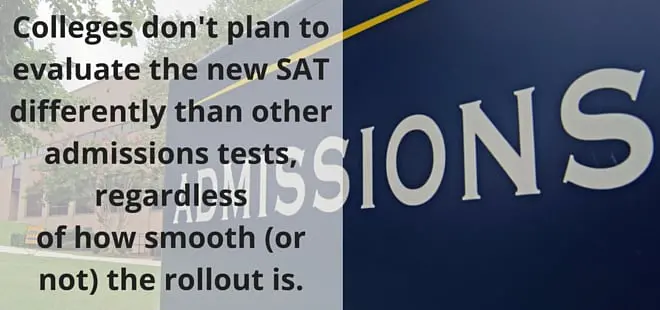The New SAT vs. The Old SAT: What’s Changed
College Board’s redesign of the SAT is rolling out this March to students across the nation. And the big question on everyone’s mind is whether students — juniors, that is — should take it. Some test prep experts unequivocally say no. Lucky freshmen and sophomores have the advantage of waiting to see what their older classmates decide. But for the trailblazing juniors, here’s what we know so far, along with a few tips for deciding what to do.
SAT Changes: What The Test Looks Like Now
[adrotate banner=”31″]For starters, the new test has been reduced from three graded sections to two — Math and Evidence-Based Reading & Writing — with an optional essay, for a top score of 1600 (the old version was 2400), with each section scored on a 200-800 scale. The overhaul aligns closely with Common Core content, just like the ACT. The idea is that the new SAT will test what students actually learn in school. Also, students no longer will be penalized for incorrect answers, so it’s okay to guess, like on the ACT. In fact, with the SAT update, the test will look a lot more similar to the ACT, which has grown hugely popular in recent years.
Reading and Writing.
A major difference between the ACT and the SAT update: the new SAT is quite a bit more reading-intensive. Gone is the difficult vocabulary section of arcane words, in what was known as the sentence-completion section. Vocabulary is now folded into prose passages, where students derive meaning from context. The test opens with a 65-minute section of reading, with five lengthy passages, followed by a 35-minute writing section. Students who sign up for the optional essay get 50 extra minutes for this section. In that essay, the student is required to cite examples from the text in response to questions; students can no longer rely strictly on writing skills. (Note that most competitive colleges do require the essay.)
Math.
This section includes more in-depth concepts, pulling from Algebra 2 and trigonometry (the old test barely addressed Algebra 2), and requires more reading to complete word problems. “For many students, the in-depth math will be much harder,” says Megan Dorsey, test prep expert and founder of College Prep Results. “Students should be finished or nearly finished with Algebra 2 in school to have a good chance of completing the math questions on the new test.” There’s a 25-minute, no-calculator section and a 55-minute section that allows a calculator.
Should Your Teen Take the New SAT?
Test prep experts advise juniors not to be guinea pigs. “There are too many unknowns at this point,” says Matt Hawthorne, co-founder of Hawthorne Learning Solutions. Also, College Board continues to refine the test, so even with available material for practicing, students don’t know for sure what they’ll see in March. College Board has released four complete practice tests, available on their website, and for the first time, it’s partnering with Khan Academy to offer a free SAT practice program. Still, Dorsey believes it’s not adequate prep material for the March test.
[adrotate banner=”24″]Also worth considering: The March results won’t be back in time for students to decide about taking it a second time in May. In the past, results were returned in three to four weeks, but the prediction is six to eight weeks for the March test. So Dorsey suggests the ACT for students who want to take an admissions test twice this spring.
For freshmen and sophomores wondering which test plays to their strengths, Dorsey recommends obtaining official copies of SAT and ACT practice tests online or at their high school’s guidance counseling office and taking a full timed test of each at the kitchen table. Other than the math, the SAT changes aren’t necessarily harder, but it’s structured in lengthier sections than the old version — about 90 minutes of reading and writing, followed by 90 minutes of math.
The SAT Update or The ACT?
“Reading fatigue is something I see as a major factor, regardless of reading skill,” Dorsey says. “Some students will do well, but I think we’re going to find those who don’t perform at their best under those conditions.” Both tests are hard and long (the new SAT is 3 hours 50 minutes with the optional essay, while the ACT is about the same), but if a student struggles with dense reading, he or she may want to consider the ACT.
As for how to prepare, experts say the best prep is to take hard classes in school. And read. “Read novels, magazines, and newspapers. It cements your language skills, reading comprehension, and vocabulary,” Hawthorne says. More immediately, take College Board practice tests, take advantage of Khan Academy, and use the College Board’s “daily practice” app.
How Will Colleges Handle the New SAT?
Students should anticipate colleges will continue to treat the ACT and the SAT just as they have in the past. These days, the majority of institutions accept either test — and they have no preference for one test over the other. “We take either one,” notes Cecilia Castellano, vice provost for strategic enrollment planning at Bowling Green State University. “And we do not treat them differently.”
What’s more, institutions like BGSU say they will not be evaluating the new SAT scores differently than they did the old SAT scores — with the exception of the new score scale — regardless of how smooth (or not) the rollout is for the latest version.
In general, says Castellano, students should take the test they feel more comfortable with. “It’s really personal preference,” she says. She adds that students may find certain academic strengths lend themselves to one test over the other. For example, the ACT has a section on science, whereas the new SAT does not.
The bottom line: help your student be prepared for whichever test she takes. “Prepare as well as you can,” says Castellano. “Go in with a great attitude. Get a good night’s sleep. And be sure to answer all the questions.”





